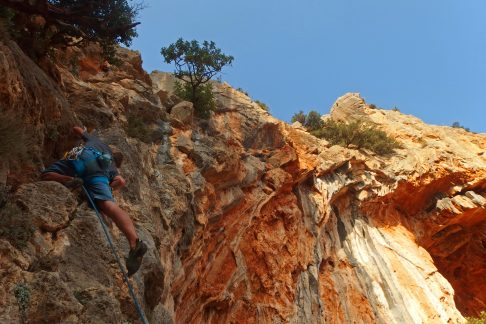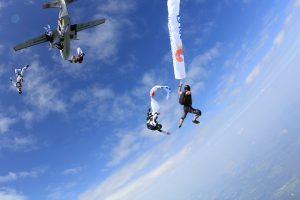What attracts people to risky sports or not only risk


For others, the matter is often simple – if someone at their own request engages in risky activities, it means that they like risk and do it for adrenaline. In reality, however, it is more complicated and there are many motivations for practicing extreme sports. Among them, the social aspect is of great importance.
Not only are there many motivations, but they also change as you gain experience. BASE jumper Jeb Corliss, when asked about this in an interview, replied:
“Things have changed over time. I’ve been doing this for so long that the reasons why I did things in the beginning are very different from the reasons why I do them now. (…) As a child I did things for one reason, as a teenager I did them for another reason, in my early twenties, it was another reason, and now, it’s something else. It’s very complex.”(1)
Ewert and Hollenhorst noted in 1989 that factors such as new experiences, excitement and making new friends are the most important in the early stages of engaging in risky sports. As one gains experience, they are motivated to develop their skills, career, status and friendship, while at a high level, their motivations become more internal and include self-awareness, the need to feel in control, achievement, and taking on challenges.
Ewert, Gilbertson, Luo and Voight published a study in 2013 that involved 801 people practicing a variety of risky sports: canoeing, whitewater kayaking, sea kayaking or rock climbing. They took into account three groups of factors that motivate to undertake these activities:
Sensation:
- test myself
- to be physically and emotionally challenged
- for the exhilaration
- fot the sense of accomplishment
- to develop my skills
- to face the risk and danger
Social:
- to have a close interaction with other people
- for the friendship(s)
- to be part of a group or team
Self-image:
- to be known as a sea-kayaker (rock climber… etc)
- to show other my skills
- for self-expression
- to be in control and make decisions
- to use my equipment
The results showed that the level of individual motivators varies depending on the type of activity, experience level and gender. For example, sensations seeking motivates climbers more than sea kayakers and canoeing enthusiasts. Self-image is the most important for beginner kayakers and the least important for those who engage in canoeing. Advanced climbers are more motivated by self-image factors than beginner climbers. For men, sensation-seeking and self-image are more important than for women, while women are more motivated by social factors.
However, what turned out to be the most important in general, regardless of gender, type of activity and level of experience, is the social aspect.
The results surprised me a bit, although I agree that the social aspect is very important. I have been skydiving for several years, now I’m into climbing, but in both sports the opportunity to meet many cool and interesting people is one of the most important factors for me that makes me want to take up these activities.
Kerr and Mackenzie interviewed 5 representatives of different extreme sports and the social factor also played a role in their research. As the kayaker they surveyed admitted:
“Initially adrenaline had a big impact because I was a teenager and suddenly it was almost a drug. We were challenging ourselves to do more difficult rivers (…) Suddenly I was feeling strong, healthy, fit… discovering some absolutely stunning places. The river is always a very privileged way to discover new environments. The adrenaline part is probably a good thing but there was also my friends were kayakers and it became a circle of friends – it became social motivation as well… But the main thing was an experience as a whole.”
The social aspect is also mentioned in interviews by famous people who engage in risky activities. As the climber Adam Bielecki says:
“In all this climbing, this interpersonal aspect is very important to me and what is special is that we enter into very close relationships regardless of age, beliefs, worldview, etc.” (2)
The climber Janusz Gołąb has a similar opinion:
“Everyone finds something different in the mountains. For example, I am always very fascinated by people and for me it is a value in the mountains, because you know, the mountains are beautiful, there are landscapes, views, but it is inanimate nature, quite dangerous (…) and this cool element who appears there is just a man.” (3)
In turn, Maja Kuczyńska, an indoor skydiving competitor, says this about parachute jumping:
“I met many interesting people, for me parachuting is a bit of a social form of flying, you can talk to your friends on a dropzone, spend time with them. It’s just a side effect of having to wait for the jumps, but it’s very cool.” (4)
Risky sports undoubtedly involve fear and adrenaline, but what motivates people to practice them is made up of many factors. The so-called Adrenaline in many people is not at all in the first place.
References
- The Man Who Could Fly: Exclusive interview with Jeb Corliss
- „Jak się nie wspinam, to staję się nieznośny” – Adam Bielecki
- Himalaiści – meeting at Pol’and’Rock 2018
- Out of Frame: Maja Kuczyńska
- Alan Ewert, Ken Gilbertson, Yuan-Chun Luo, Alison Voight (2013). Beyond “Because It’s There”, Journal of Leisure Research, 45(1), 91-111. (pdf at researchgate.net)
- John H. Kerr, Susan Houge Mackenzie (2012). Multiple motives for participating in adventure sports, Psychology of Sport and Exercise, 13(5), 649-657. (pdf at calpoly.edu)
Author: Maja Kochanowska






Add comment